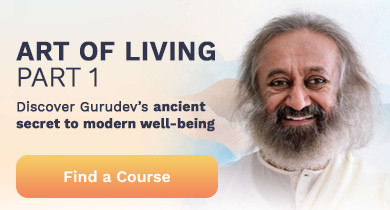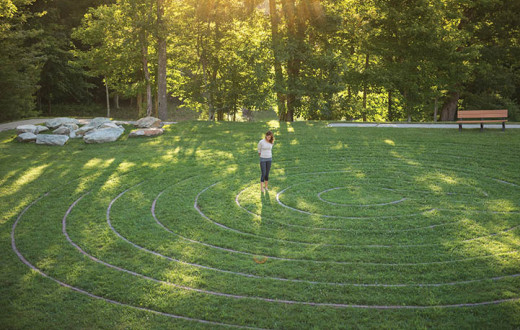By Sriram Sarvotham | Posted: March 13, 2019
The famous Austrian neurologist, psychiatrist, and Holocaust survivor, Dr. Viktor Frankl, wrote in his best-selling book Man’s Search for Meaning, “Everything can be taken from a man but one thing: the last of human freedoms—to choose one’s attitude in any given set of circumstances.”
This profound recognition of the freedom to choose our state of being regardless of any circumstances came to Dr. Frankl in the midst of his heart-wrenching experience as an inmate at a concentration camp in the early 1940s.
The practice of meditation is exercising this freedom to choose a harmonious and peaceful state of being. The words “practice” and “exercise” may give a connotation of effort, but this is not so. A more accurate way of stating it would be: meditation is a state of well-being where we allow ourselves to experience the bliss of inner peace.
We don’t require extreme situations in life — such as the experiences of Dr. Frankl — to make us yearn for inner peace. Our day-to-day life is rife with stressful situations. Rather than allowing our state of being to be tossed around by events outside, meditation invites us to choose peace from within. Not only does this bring great peace of mind, it allows us to respond to challenging situations with a beautiful blend of centeredness and awareness.
What exactly is meditation?
In this post, we will see what meditation is from the perspective of the science of yoga. We look at the definition of meditation according to Maharishi Patanjali. We also look at the benefits of meditation that Patanjali describes in his Yoga Sutras. This post is the first of two blog posts on meditation. The second post will address how to quiet incessant mental chatter, based on the teachings of Patanjali. In particular, we look at how to prepare the body and mind for a blissful experience of meditation.
Before we explore meditation further, allow me to clarify the intent of this post. In order to experience blissful meditation, intellectual understanding of what it is or the mechanics of the process is really unnecessary. We don’t need to understand the physiology of sleep to enjoy a good night's sleep. We also don’t need to understand the physics of sound and harmonics to enjoy melodious music! The intent of this series is to recognize the value of meditation and inspire a sense of respect and appreciation for it. As Patanjali says in Yoga Sutras, when we do the practices with gratitude, honor and respect, it profoundly elevates the quality of the practice.
Meditation is one of the limbs (segments) of the 8 limbs (ashta-anga) of yoga as taught by Patanjali. The first five limbs are grouped together as external practices; these practices deal with the well-being of the external instruments such as the body, breath, senses, etc. The last three limbs, namely concentration (dharana), meditation (dhyana) and equanimity (samadhi) are internal practices, as they address the harmony of our inner faculties. After describing the 5 limbs of external practices, Patanjali begins his teaching of internal practices in a new (third) chapter in his Yoga Sutras.
How does Patanjali define meditation?
The definitional sutra (aphorism) is – Tatra pratyaya ekatanata dhyanam. Loosely translated as – Meditation is the alert state of mind that remains the same from one moment to the next. The mind, filled with awareness, is so still, so calm, so free of disturbance that from one moment to the next, the state of mind is identical.
As an analogy, consider the surface of a lake. When the surface is free of disturbance or turbulence, an object on the surface of the lake (say, a flower) remains in the same spot from one moment to the next. Furthermore, there’s no effort to keep the surface still; there’s no effort to keep the flower in the same spot. It just is. When our mind is similarly free of disturbance, we experience meditation. It happens effortlessly.
The difference between meditation and deep sleep is awareness. (While the analogy of the surface of the lake brings out the quality of stillness and tranquility, perhaps it does not convey the element of aware presence. There are several other analogies that bring out this and other facets of meditation, which we can discuss later). This seemingly tiny difference — the presence of awareness — profoundly impacts our experience of bliss. Meditation harmoniously blends deep relaxation and elevated awareness.
Patanjali describes what happens when we experience meditation in the sutra — Dhyana heyaha tad vrittayaha — meaning meditation calms the turbulence in the consciousness. In fact, Patanjali defines yoga as releasing the turbulence (vrittis) in his famous sutra Yogah chitta vritti nirodhaha, translated as ‘yoga is the cessation of the fluctuations of the mind.’ Meditation therefore takes us to the deepest experience of yoga.
Any disturbances or agitations consume energy. In fact, mental chatter is an unnecessary expenditure of precious energy; it serves no useful purpose. When we bring the mind to stillness, we stop this unnecessary drain. The same energy can now be used to transform the state of mind into higher states of awareness. In other words, by relaxing the chatter, we also feel more alive. The restlessness (rajas) and dullness (tamas) give way to clarity and heightened awareness (sattva).
When we come out of meditation, we see any ‘problems’ that were bugging us from a totally new perspective, namely that of elevated awareness, so we can respond from there. Not only that – we’re also in a space where creative solutions to solve problems can be born.
Meditation brings us in touch with the deepest aspects of our self. It’s easy to see the depth of a lake when the surface is free of disturbance; in like manner, it’s easy to get in touch with the depth of our being in meditation. It unites us in harmony with our own self. We’re well rested, reposing in our inner cozy comfort! Not only is this pleasant to experience, it also profoundly transforms the quality of our actions. Let’s see how.
Meditation and action
All of us have deep intentions from our true nature, such as joy, love, vitality, friendliness, to be of value, to be courageous, to serve and uplift others, etc. However, in daily life we get caught up with activities (disturbances) outside, so that we lose our connection with these deepest intentions. Consequently, we display actions not in harmony with these intentions. Perhaps we get angry, complain, or become lazy. In fact, we may unleash copious amounts of anger and a plethora of negative energies on our closest companions! Actions originating in such negative states of mind don’t make us proud of ourselves. Indeed, we usually regret actions that come from anger.
With the practice of meditation, we commit to staying connected with the depths of our self. And something beautiful unfolds in our lives – our actions fall (rise!) in harmony with our true intentions. Our actions reflect the truth of who we really are! Furthermore, our actions are powerful – due to the resonance between what we express and our true identity.
There is a teaching in Bhagavad Gita that says – be established in yoga and then perform your actions (Yogasthah kuru karmani). Furthermore, one definition of yoga given in the the Gita is skill in action (Yogah karmasu kaushalam). From my understanding, the skill needed in action is aware presence, or allowing our actions to be inspired from connectedness with our self. That way, we express the nature of who we really are (joy, love, etc). In this context, Gurudev Sri Sri Ravi Shankar says, “Offer actions as an expression of joy rather than as an expectation of joy.”
The relationship between meditation and action has been considered by Patanjali as well, in the Yoga Sutras. Tatra dhyanajam anashsayam — that which is born out of a meditative state of mind is free from imprints or accumulations. An example of an imprint (ashaya) is the karmashaya – which Gurudev Sri Sri Ravi Shankar describes as the “Karma Tank,” the repository of karma. What the sutra says is that actions inspired from a meditative state do not leave a trail or residue that will affect our future experiences; the action and the experience are complete in itself, in the moment.
To summarize, meditation brings great peace by calming the disturbances in the mind. It aligns our actions with our deepest intentions, and makes the actions powerful. Because of our peaceful presence, the world responds to us in like manner. To quote the words of the well-known author Ken Keyes, Jr., “A loving person lives in a loving world. A hostile person lives in a hostile world.” Allow me to extrapolate – “A peaceful person lives in a peaceful world.”
This article was originally published on Sriram’s Blog. See part 2 of this series by clicking here.
Shriram Sarvotham, yoga teacher since 1991, holds a PhD degree in Electrical Engineering from Rice University, Houston, TX. He works in the tech industry in Silicon Valley California.





























